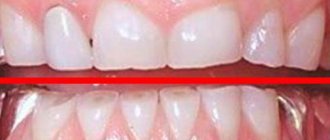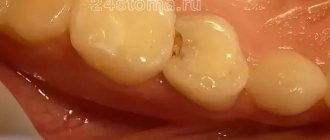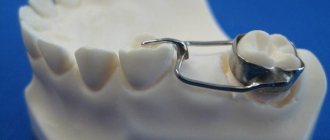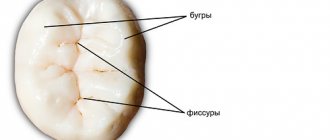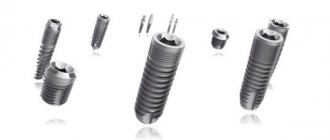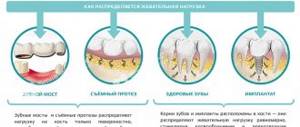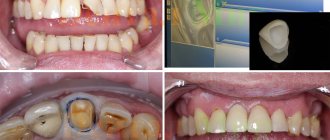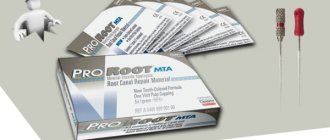From this article you will learn:
- whether wisdom teeth are treated or removed,
- indications and contraindications for treatment,
- Is it possible to remove a wisdom tooth - while it has not yet erupted.
Wisdom teeth are called eighth teeth - according to the serial number in the dental formula (counting is from the central incisors, respectively, for each half of the dentition of the upper and lower jaw). There are four wisdom teeth in total, and they always begin to erupt in the jaw later than all other teeth in the permanent dentition - usually between 18 and 21 years, although in some cases this can happen at 14 years, and even after 40 years. Is it necessary to remove wisdom teeth since they cause so many problems for most of their owners?
To remove or treat a wisdom tooth is determined in dentistry according to a number of criteria. For example, the most important of them is whether there is enough space in the dentition for their normal eruption. After all, for example, if the length of the lower jaw is insufficient, then the lack of space in the dentition will certainly cause their difficult eruption, accompanied by inflammation of the gums and pain. But that's not all, because... the constant pressure of a wisdom tooth trying to erupt on the 7th tooth in front is highly likely to lead to displacement of the teeth and the occurrence of crowding in the anterior sections of the dentition.
Eruption of wisdom teeth –
But very often the question: is it worth removing wisdom teeth - is asked in relation to already erupted, for example, partially destroyed eighth teeth. Whether such wisdom teeth are treated depends, for example, on the correct position of the tooth in the dentition, or on the presence of an antagonist tooth (with which the closure occurs), etc. Moreover, the opinion of dentists of different specializations may differ radically. For example, when you visit a dental surgeon, the doctor may immediately recommend that you remove it, just so as not to sit idle. The same applies to dental therapists.
It is best for the decision on the need to remove or treat a wisdom tooth to be made by an orthopedic dentist (prosthetist), because the most important thing is to make this decision precisely from the point of view of the need for this tooth for prosthetics in the future. As for the issue of removing figure eights if their eruption is difficult, it is advisable that such a decision be made by an orthodontist. Because, again, when you have an appointment with a dental surgeon, often such doctors do not even look at the length of the jaws, but immediately recommend removing the eights, although they could have erupted quite normally.
What is an occlusive agent?
We will reveal to you secrets from the world of cosmetology that dermatologists and cosmetologists will not tell you about! Discover beauty secrets and recommendations from BFN to always look flawless!
Skin moisturizing. Occlusion
Let's continue the conversation about increasing skin hydration. Let's talk today about how to retain moisture in the skin and prevent its rapid evaporation, that is, about occlusion.
Water continuously rises from the depths of the skin to its surface and then evaporates. If you slow down its evaporation by covering the skin with something gas-tight, the water content in the epidermis will increase quite quickly. This method is called occlusal.
If the film is completely impenetrable, the epidermis will become too wet, which will lead to swelling of the stratum corneum and destruction of the barrier. A so-called “greenhouse” effect will be created.
But a semi-permeable film slows down, but does not completely stop, the evaporation of water. It will relieve the symptoms of dryness without damaging the skin.
Ingredients that slow down water evaporation vary in occlusion strength:
• Mineral oils, petroleum jelly, liquid paraffin are hydrocarbons, petroleum products;
• Lanolin is an animal wax obtained from sheep wool;
• Animal fats – goose, whale, pork;
• Squalene and its derivative squalane are a natural component of human sebum; obtained from shark liver and some plants;
• Vegetable oils rich in saturated and monounsaturated fatty acids. For example: shea butter (karite), mango, prakaxi, cocoa, etc.
• Natural waxes – beeswax, vegetable waxes.
Vaseline and other mineral oil derivatives create too much occlusion, and can slow down the restoration of the epidermal barrier - the cells will not receive a signal in time that the barrier needs repair. Therefore, choose cosmetics that do not contain these components! Owners of combination and oily skin should especially pay attention to this.
Give preference to cosmetics that contain components that create a slight occlusion: natural waxes, vegetable oils and vegetable squalane.
Occlusive creams quickly eliminate dry skin, reduce inflammation and itching in skin diseases. They are necessary for the skin, for example, for protection in winter. However, they should be used only at the initial stage, since they do not act on the cause of skin dehydration - a violation of the barrier function of the stratum corneum.
Components related to the skin will help restore the stratum corneum. These are ceramides, cholesterol and oils, especially rich in Omega-3 and Omega-6 polyunsaturated fatty acids. However, you should be patient: the process of restoring the stratum corneum is not quick, but as a result you will get healthy skin that can withstand the aggressive effects of the environment.
Source
General information
Vascular occlusion is a blockage (more often of arteries than veins), which is characterized by a pronounced decrease in the speed and quality of blood flow. Occlusion can cause necrosis and, as a result, lead to death. The pathology is quite common and can affect the organs of visual perception, the central nervous system, limbs and great vessels.
sepsis and peritonitis develop . Abdominal ischemic syndrome develops against the background of a lack of adequate blood circulation in the digestive tract. The pathology is associated with occlusion of the unpaired visceral branches of the abdominal aorta - the celiac trunk and mesenteric arteries (superior, inferior). Abdominal toad can develop under the influence of both internal ( thrombosis ) and external factors (traumatic occlusion).
What is an occlusive dressing?
This method of sealing the lesion is used for wounds that require maintaining sterile conditions and protection from the external environment.
Applying an occlusive dressing to the knee joint requires certain skills and technique:
- cover the wound surface with sterile gauze;
- Place the top of the scarf on the thigh area and wrap it around the waist;
- bend the bandage at the base by 2 cm;
- cross the ends under the thigh, tie knots on the thigh;
- Throw the top over the knot formed and then pass it under the knot.
Pathogenesis
When the blood thickens, there is an accumulation of fibrin in its composition, which leads to thrombus formation . Venous formations are characterized by constancy - they are located in one area and clog the vessels of the extremities, leading to necrosis and gangrene . Arterial formations are characterized by migration; they often break away from the original source and disrupt the blood supply to large organs, provoking the development of stroke , heart attack and other dangerous conditions.
Postpone prosthetics - reduce life expectancy
The gap formed in the dentition not only disrupts the aesthetics of the smile. Untimely dental prosthetics significantly worsens the general condition of the oral cavity, which over time leads to accelerated aging of the entire organism.
The teeth in the jawbone rest on each other. The loss of support on one side forces them to move horizontally and vertically in search of new support. Therefore, tooth removal triggers a chain deformation of the entire dentition. The teeth do not move on their own, but together with the corresponding part of the bone, provoking the gradual appearance of quite serious troubles:
- tilt of the remaining teeth towards the removed one;
- advancement of the antagonist tooth towards the vacant space on the opposite jaw;
- the formation of interdental gaps and the appearance of crowding of teeth, causing inflammation of periodontal tissues;
- change in the angle of the lower jaw and overload of the temporomandibular joint;
- change in bite height and deformation of the smile line even with healthy incisors and canines;
- increased wear of teeth exposed to excessive stress.
As a result, refusal to implant teeth over time causes the need for treatment of periodontitis, disruption of chewing function and digestion, changes in appearance and disturbance of speech function. Let's figure out why this happens.
Classification, types of occlusion
It is customary to distinguish between arterial and venous occlusion.
Types of occlusion by localization:
- Occlusion of mesenteric vessels . It is characterized by an acute circulatory disorder in the mesenteric vessels, which inevitably leads to intestinal ischemia. As a result of thrombosis, the trophism (nutrition) of the intestinal walls is disrupted, and an acute inflammatory process develops, including peritonitis .
- Occlusion of cerebral vessels. The gradual growth of cholesterol plaques in volume can lead to complete blockage of the vessels supplying blood to the brain. The vessels lose their elasticity and a blood clot forms at the site of attachment of the cholesterol plaque as a result of platelets adhering to the damaged vascular wall.
- Occlusion of the arteries of the lower extremities. In this case, a sharp closure of the lumen of the peripheral artery and the development of an acute form of ischemic syndrome are characteristic. Such changes lead to disruption of trophism and nutrition of the lower extremities, paralysis and even gangrene . With occlusion of the femoral artery, extensive circulatory disorders develop not only in the lower extremities, but also in the pelvic organs, which can pose a real threat to the life and health of the patient. Both the superficial (SFA) and deep femoral artery can be affected.
- Occlusion of cardiac vessels. Damage to the coronary arteries is very common. When the supply vessel is completely blocked, irreversible consequences develop in the form of necrosis - myocardial infarction . ischemia develops , which manifests itself as signs of angina pectoris . The blockage can occur due to a blood clot or atherosclerotic plaque. With long-term, chronic occlusion, bypass pathways are formed - collaterals, through which nutrients are supplied. In 98% of cases, the coronary arteries are affected by atherosclerosis .
- Occlusion of the subclavian artery. As a result of blockage, ischemia occurs not only in the upper extremities, but also in the brain. Dizziness , weakness in the arms, problems with speech and visual perception appear The consequences of occlusion of the subclavian arteries are severe.
- Occlusion of the carotid artery. There is both complete and partial blockage of the vessels that supply blood to the brain. Occlusion of the internal carotid artery, which nourishes and supplies the brain and is responsible for intracranial circulation, is rare. Damage to the common carotid artery can lead to problems with visual perception.
- Occlusion of the iliac artery. The first manifestation of the lesion is numbness in the legs, fatigue, ischemia of the legs, and the appearance of pain when walking. Gradually, damage manifests itself in the functioning of the pelvic organs, impotence , and the functioning of the abdominal organs is disrupted.
- Occlusion of the eye or occlusion of the retinal artery. It is extremely rare. It is characterized by a completely asymptomatic course and a sudden deterioration in vision up to complete blindness.
What does prolonged absence of teeth lead to?
If you have lost a tooth, we recommend that you do not delay replacing it for a long time. In addition to an aesthetic defect, long-term absence of a tooth can lead to a number of negative consequences, which not everyone knows about. We will talk about the main problems that can be encountered if the integrity of the dentition is not restored.
Change in appearance
The dentition is a single, well-coordinated mechanism that functions fully only if it is intact. The load when biting and chewing food is distributed evenly both on the teeth and on the periodontal tissue (which surrounds and holds the tooth).
In addition to the chewing function, the preservation of the dentition affects a person’s diction and appearance. If front teeth are missing, lip recession may develop, the loss of canine teeth can change the smile, and the removal of chewing teeth can change the line of the cheeks. Soft tissues remain without support, the proportions of the face change, the corners of the mouth sag down and nasolabial folds appear. The motility of small facial muscles changes, exacerbating existing wrinkles and contributing to the appearance of new wrinkles.
Increased load on other teeth
Each group of teeth performs its own function, and when the chewing teeth are lost, the front teeth take over their function, but their anatomical structure does not correspond to the load placed on them. This leads to abrasion of the edges of the tooth, the appearance of cracks and darkening on the enamel. The height of the bone tissue that holds the tooth decreases, and over time, teeth that are under excessive load acquire pathological mobility, in other words, they begin to loosen.
Tooth displacement and the occurrence of functional disorders
After a tooth is removed, its antagonist (the tooth of the opposite jaw, with which it comes into contact during chewing) loses support and moves. The same thing happens with neighboring teeth on both sides of the removed one. This leads to the formation of malocclusion, uneven dentition and disorders in the jaw joints, which can lead to arthrosis. Patients develop functional gastrointestinal disorders: gastritis, pancreatitis, cholecystitis.
Bone loss
3–5 months after tooth extraction, the bone tissue that previously supported the tooth and could become a support for the implant begins to decrease, which is due to the lack of the previous chewing load. For example, a similar situation occurs with muscles after applying plaster. The longer a patient waits to see a dentist after tooth extraction, the more pronounced the bone deficiency becomes, and the more difficult the implantation procedure will be in the future.
Fortunately, modern technologies make it possible to restore the dentition even with complete loss of teeth and bone tissue atrophy, but the sooner the patient consults a doctor, the easier and cheaper it will be.
The possibilities of modern dental restoration techniques, fortunately, are practically unlimited: implant-supported crowns, orthopedic bridges and removable dentures. MedGarant specialists will always be able to offer the best option for you. Make an appointment and your doctor will create an individual treatment plan for you.
Make an appointment with a doctor by calling:
- Clinic on the street. Smolenskaya, 9
+7 Make an appointment
- Clinic on the street. Badaeva, 6, building 1
+7 Make an appointment
- Clinic on Menedeleev Blvd., 9, building 1
+7 Make an appointment
Causes
Most often, occlusion develops as a result of embolism, blockage of a blood vessel by a dense formation. This process can develop as a result of:
- Infectious disease . In this case, the blood flow is blocked by inflammatory-purulent blood clots or the accumulation of a large number of pathogenic microorganisms.
- Air embolism . It develops as a result of an air bubble entering the systemic bloodstream. It is determined after traumatic damage to a vessel or after an incorrectly performed injection.
- Fat embolism . As a result of metabolic , fat particles accumulate and a fat clot forms from them.
- Arterial embolism . Thrombi form on the valve apparatus of the heart and are characterized by instability and mobility, which can lead to separation of thrombotic masses and blockage.
Occlusion of the vessels of the neck and coronary arteries is formed in the area of their branching or narrowing.
- malignant neoplasms;
- atherosclerosis;
- traumatic injuries;
- aneurysms;
- thromboembolism.
As a result of traumatic damage to muscle tissue and the skeletal system, compression occurs and blood flow is blocked.
Treatment of occlusion by dentists
There are many ways to correct a crooked bite. Among them:
- Physiotherapy. Used in the simplest cases. A person performs exercises that improve the position of the jaws by relieving tension in certain areas of the oral cavity.
- Wearing braces. Such designs include a fixing arch and clasps that force the teeth into the correct positions. With the help of braces you can cure the most serious disorders. For those who are afraid of the unaesthetic appearance of metal systems, dentists offer ceramic and lingual (glued to the back of the dentition) products.
- Aligners. Analogues of braces. They look like transparent aligners. They are made from personal casts. Suitable if the curvatures are not very serious and the patient’s age does not exceed eighteen years.
- Plates. An affordable option for correcting your bite. But it is only suitable for children whose age does not exceed twelve years.
- Surgery. This is a radical way to treat occlusion. Dentists resort to it if the available traditional methods do not provide the desired result. Surgery is necessary for congenital malformations of the jaws, frontal open bite, chin dysplasia, curvature of the alveolar processes after injury, bone tumors. Surgical therapy will have to be abandoned if the patient has progressive tuberculosis, decreased blood clotting, or untreated inflammatory diseases of the oral cavity. The operation to correct occlusion is performed exclusively under general anesthesia. This is a fairly complex and serious intervention. Afterwards, long-term rehabilitation is required.
Symptoms
Against the background of damage to the brachiocephalic vessels, there is a decrease in performance, weakness and dizziness . The brachiocephalic trunk is responsible for the blood supply to the soft tissues of the head and the brain. If the left artery is additionally involved in the pathological process, then the clinical picture worsens significantly. Main manifestations:
- pale skin;
- nausea;
- headache;
- pain during physical activity;
- confusion;
- paraplegia;
- swelling and development of necrosis;
- burning sensation or numbness;
- deterioration of visual perception;
- hallucinations;
- difficulty breathing, swallowing;
- speech disorders;
- cardiopalmus;
- absence of pulse in the affected area.
If any of the above symptoms appear, it is necessary to conduct a thorough analysis and diagnosis to identify the true cause and subsequently prevent the development of severe complications.
The problem of occlusion in dentistry
If you do not engage in improper jaw closing, you will be bothered by:
- Difficulty chewing food. When eating solid foods, a person will hear clicking sounds and feel discomfort.
- Frequent headaches. Some patients think that they are weather dependent or associate the symptom with nervous experiences. In fact, the problem lies much deeper - in the disease of the oral cavity.
- Pathological abrasion of tooth enamel. This is a serious problem. The crowns are thinning. Cracks and chips form. Hence the need for prosthetics.
- Constant biting of tissues located on the inside of the cheeks. Because of this, stomatitis will often occur.
- Palate injuries. Caused by improper chewing of food.
- Alveolar ridge atrophy. Occurs due to uneven and improper distribution of the chewing load.
- Difficulty in nasal breathing. The patient has to open his mouth slightly so as not to experience a lack of oxygen.
Tests and diagnostics
It is recommended to consult a doctor at the first manifestations of the disease. After examination, collecting anamnesis and assessing the manifestations of clinical symptoms, they begin diagnostics, which includes:
- CT arteriography;
- Doppler ultrasound;
- cerebral angiography;
- MR angiography;
- coagulogram;
- MRI of the brain.
Only after a comprehensive examination is appropriate treatment prescribed, which is selected individually for each patient.
Emollients, humectants and occlusives: moisturize the skin with them!
What are emollients, humectants and occlusives in moisturizers and how do you know what you need?⠀
Humectants attract water both from the deeper layers of the skin and from the environment.
These are hygroscopic (absorbing moisture from the air) substances with a molecular structure containing several hydrophilic groups, such as hydroxyl groups (OH) and amino groups (NH2). Humectants draw water from the dermis into the epidermis and stratum corneum of the skin, and are also able to attract steam from the air, helping to moisturize the skin at relative air humidity of more than 50%.⠀
These include: hyaluronic acid, glycerin, peptides, urea, α-hydroxy acids, amino acids, aloe vera, honey.⠀
For whom? Products with humectants can be used on any skin type, but they are most suitable for people with normal to dry skin. ⠀
Emollients are an oily substance that fills the space between dead skin cells, forming a smooth film on its surface that makes the skin visually and tactilely smooth.⠀
These include: oils, esters, lipids, ceramides, fatty acids.⠀
For whom? They suit almost everyone, but there are exceptions. For example, people with oily or problematic skin should avoid products with comedogenic emollients (coconut and avocado oils) and use non-comedogenic ingredients (jojoba oil, safflower oil or squalane) to prevent clogged pores and acne.⠀
Occlusives form a protective layer on the surface of the skin, preventing moisture loss.⠀
These include: petrolatum, mineral oil, dimethicone, mineral oils, petrolatum, lanolin, wax.⠀
For whom? Occlusives are most suitable for people with very dry skin or skin conditions (such as eczema or psoriasis). Also, applying moisturizers immediately after taking a bath is an effective way to retain additional moisture in the skin. People with oily and problematic skin should avoid all occlusives.⠀
Source
Facial skin moisturizers. How to choose
We too often complain about the feeling of tightness of the skin after washing, the roughness of the face and, in general, dry skin. It would seem, take a moisturizer, and the problem is solved! Proper cosmetic care can almost always improve the condition of your skin.
But visiting cosmetics stores does not cause optimism: there are so many offers of products for moisturizing the skin of the face that it causes some confusion.
To learn how to choose the right moisturizers, let's get acquainted with how creams work.
Before making a choice, let's determine the signs of dry skin, which is not so easy to do. Before cosmetically influencing the epidermis, conduct testing and determine the necessary indicators to identify problems. This is the degree of moisture and sensitivity of the skin, its type.
Internal and external culprits of dry skin
Those young ladies whose sebaceous glands do not work well and lack sebaceous secretion complain about the dryness of the upper layer of skin. Surprisingly, people with oily skin who produce excess sebum also suffer from similar negative symptoms.
The reason lies in the fact that symptoms of tightness, irritation, and roughness begin to appear due to a lack of water in the epidermis.
Unlike other layers of the skin, the stratum corneum contains insufficient moisture (only 15%). Although the epidermis consists of dead cells, it also needs a sufficient amount of water. Moisture ensures the plasticity of the top layer of skin and its integrity. On the contrary, the cells of the deep layers ensure their vital functions with the help of water.
Lack of moisture in the epidermis causes the destruction of the barrier functions of the skin and disruption of the structures of the stratum corneum, which, like a brick wall, consists of dead keratin scales.
How to recognize pathology
The following symptoms indicate a violation of occlusion:
- Strange and unnatural face shape. The chin looks too small, practically does not protrude forward. He can look to the side. This makes a person always seem sad or angry. In fact, this anomaly makes it very difficult to smile.
- The upper and lower lips do not close when the mouth is relaxed. In order for them to adhere to each other, a person has to strain a lot. As a result, the patient always walks with his lips parted.
- The teeth are crowded, overlap one another, or, on the contrary, there are large gaps between them.
Doctors easily make the correct diagnosis of occlusion. But sometimes an external examination alone is not enough. Then more complex studies are involved in the diagnosis.
Occlusive effect. How do occlusive moisturizers work?
Water constantly seeps from the lower layers of the skin to the surface and evaporation occurs.
The amount of moisture in the epidermis will increase incomparably if such evaporation is slowed down. This method of retaining moisture is called occlusive. This may be a semi-permeable film on the surface of the epidermis, which will inhibit the evaporation of water.
Substances that create a film
- Silicone oils.
- Products that appear during oil refining are mineral oil, liquid paraffin, ceresin.
- Animal wax extracted during the cleaning of sheep wool, lanolin.
- Animal fats - goose, pork, whale.
- Squalene is a natural constituent of human sebum.
- Solid vegetable oils.
- Natural waxes (bees, pine, reed).
The presented moisture-saving products are characterized by different levels of occlusion.
The strongest is Vaseline, but it creates excess greasiness. In addition, Vaseline makes it difficult to restore the skin barrier, because oily skin reduces the sensitivity of cells. As a result, they cannot receive a signal that the barrier needs to be repaired.
Occlusive moisturizing creams make it difficult for water to evaporate from the surface of the epidermis. They quickly restore the required level of moisture and remove peeling.
However, moisturizing occlusive cosmetics do not treat the cause of dryness (damaged barrier). Such creams are necessary if the barrier properties of the skin can no longer be restored, but if there is hope of restoration, such cosmetics are necessary only for the first stage of treatment.
Occlusive creams can be used after peeling. They will become an “ambulance” for the damaged stratum corneum.
By the way, I note that any moisturizing cosmetics contain occlusive elements, but some products have this ingredient as the main one, while others - as an auxiliary one.
Content:
- Causes of occlusion
- The problem of occlusion in dentistry
- How to recognize pathology
- Establishing diagnosis
- Treatment of occlusion by dentists
- If left untreated
The term “occlusion” in dentistry means:
- Contact between the upper and lower teeth, the degree of their closure. In this case we are not talking about any deviations from the norm.
- Bite abnormalities specific to a particular person. Such conditions require observation by a dentist and proper correction.
The correct functioning of the masticatory muscles depends on the characteristics of the occlusion. If the upper and lower teeth are positioned incorrectly in relation to each other, treatment is necessary.
Below we will look at occlusion as a sign of dental disorder. Today, cases of malocclusion caused by underdevelopment or, conversely, strong development of one of the jaws are very common.
Moisturizing creams using the “wet compress” method
You can quickly moisturize the stratum corneum of the skin. Let's say with the help of hygroscopic compounds that not only bind water molecules, but also retain them.
Moisture hunter creams are divided into two classes, and each retains water in its own way.
For example, polymer molecules - they cannot get inside the skin due to their large size. Therefore, the elements are located on the surface and form a wet compress, sucking moisture from the surrounding air like a sponge.
Moisturizing polymers include:
- glycerol;
- polysaccharides (chitosan, hyaluronic acid, pectin, polysaccharides);
- sorbitol;
- protein molecules of elastin and collagen;
- polynucleic acids.
Emulsion creams and gels contain similar polymers, but they are especially abundant in watery products such as toners and lotions.
However, in dry weather conditions, when the humidity of the outside world is less than that of the upper stratum corneum, the use of moisturizers that work like a “wet compress” is not justified. The cream will draw water out of the skin, making it even drier. Such cosmetics will really help if there is enough moisture in the environment. The epidermis will become soft, tightened, and small wrinkles will be smoothed out.
What happens in the skin in the case of a “wet compress”?
The moisture created by the cosmetics dries on the surface of the skin, beginning the lifting process. High-molecular accumulations stick to the stratum corneum, dry out and shrink, dragging the epidermis with them. Moreover, the more the “compress” dries out, the more pronounced the degree of tightening is.
It is important that the water from the compress evaporates slowly; for this purpose, occlusive components are introduced into the cream or complementary tandems are used. Let's say toner plus moisturizer.
Professional products are cosmetics that use a second technique. It makes it possible to select cosmetics based on your skin type and climate.
How does deep skin moisturizing cream work?
It is a misconception to think that deep moisturizing cosmetics moisturize the entire thickness of the skin: only the epidermis layer is saturated with water.
The constituent elements of NMF (natural moisturizing factor) - lactic acid, urea, amino acids - play the role of a natural sponge. They are located in the stratum corneum, bind moisture and, with its help, smooth the surface plates. The skin becomes smooth and elastic. Moreover, the good thing is that the natural exfoliation of the skin is not affected.
A distinctive feature of NMF is to penetrate into the epidermis and increase skin hydration. True, the process is less pronounced and occurs more slowly if you compare it with a “wet compress,” but it lasts longer and does not depend on the amount of environmental moisture.
Establishing diagnosis
Among the diagnostic techniques used in studying the characteristics of occlusion:
- Dental test. The client is asked to tilt his head back and open his mouth slightly. The doctor places his index fingers on the lower dentition and fixes them in a stationary position. After this, the patient is asked to swallow saliva several times. When making swallowing movements, the jaws begin to move involuntarily. By observing their movement, a specialist can assess the degree and correctness of row closure.
- Anatomical study. Using a special measuring instrument and clamps, the doctor evaluates the proportional relationship of the face along two axes - horizontal, vertical.
- Radiography. Allows you to study the structure of the jaws, to understand whether there are unerupted teeth.
- Taking impressions. A man bites a wax blank. By looking at the impressions taken, the dentist can tell for sure whether there is an abnormal occlusion.
